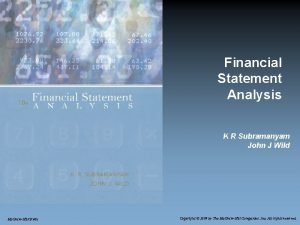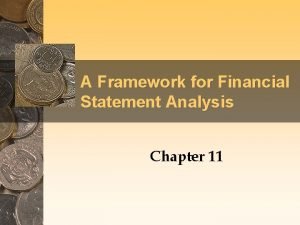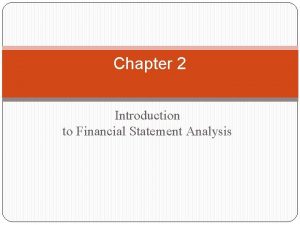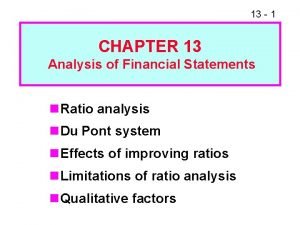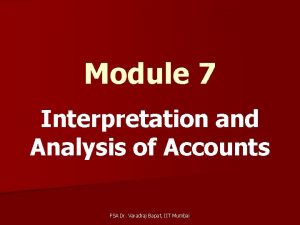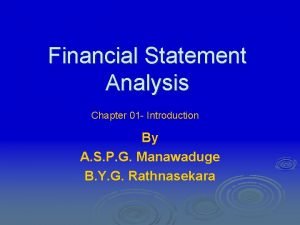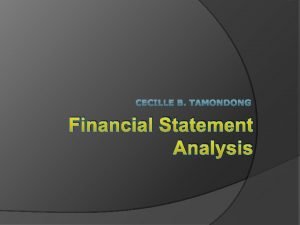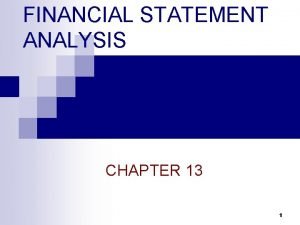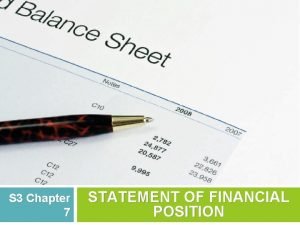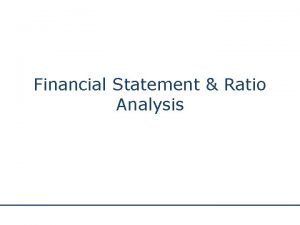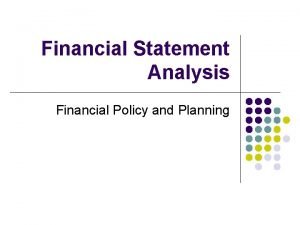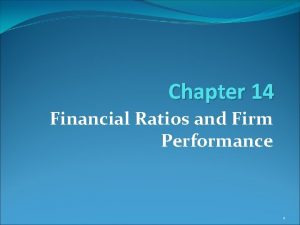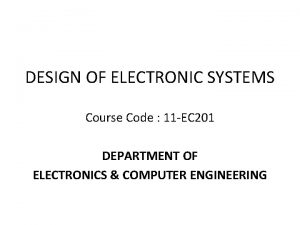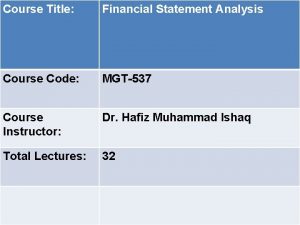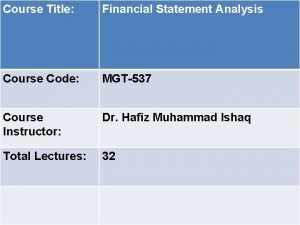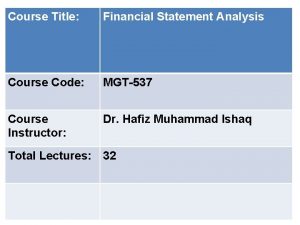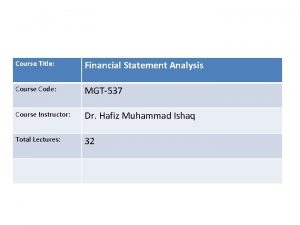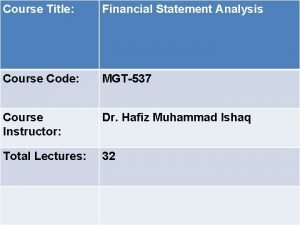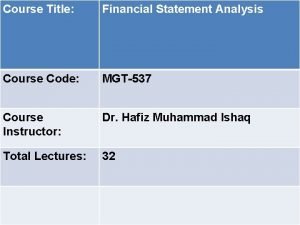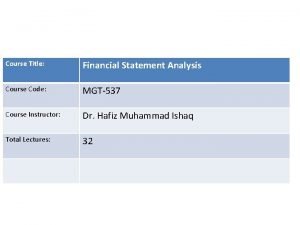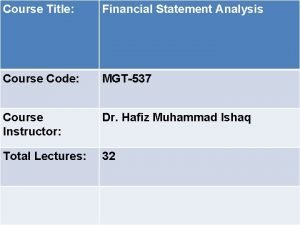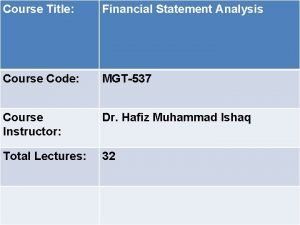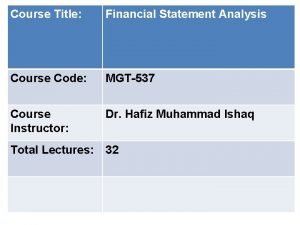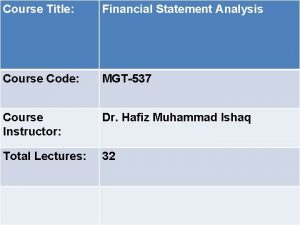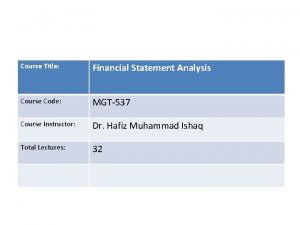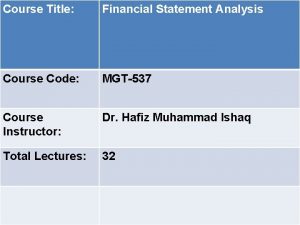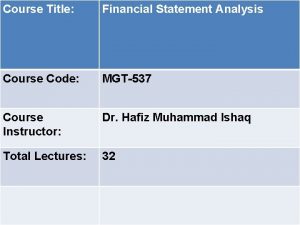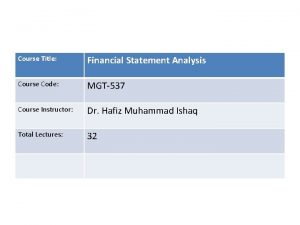Course Title Financial Statement Analysis Course Code MGT537






















- Slides: 22

Course Title: Financial Statement Analysis Course Code: MGT-537 Course Instructor: Dr. Hafiz Muhammad Ishaq Total Lectures: 32

Lecture 2 nd Topics • Forms of Business Entities • The Financial Statements • Balance Sheet (Statement of Financial Position) • Income Statement (Statement of Earnings) • Statement of Owners Equity • Statement of Cash flows • The Accounting Cycle, Auditor’s Report

Forms of Business Entities

The Financial Statements ØIncome statement ØStatement of stockholders’ equity ØBalance sheet ØStatement of cash flows ØSupport for the financial statements is provided by notes

Income Statement • Dated for a specific period • Summarizes revenues and expenses • Reports net income üExcess of revenues over expense • Net income increases retained earnings Income Statement Revenue $ 120, 000 Expenses (100, 000) Net Income $ 20, 000

Statement of Stockholders’ Equity • Dated for a specific period • Reconciles beginning and Revenue Income Statement$ 120, 000 ending balances of the Expenses (100, 000) stockholders’ equity Net Income $ 20, 000 accounts Statement of Stockholders’ Equity üCapital Stock Capt. Stk. Ret. Earn. üRetained Earnings Etc. Beginning Balance $20, 000 $ 5, 000 • Links the income statement Net income 20, 000 Dividends (10, 000) and the balance sheet Ending Balance $20, 000 $ 15, 000

Balance Sheet Shows the financial condition of an entity as of a particular date Assets: the resources of the business Liabilities: the debts of the business Equity: the owners’ interest in the business The Accounting Equation: Assets = Liabilities + Stockholders’ Equity Assets = Liabilities + Capital Stock + Retained Earnings Income Statement Revenue Expenses Net Income $ 120, 000 (100, 000) $ 20, 000 Statement of Stockholders’ Equity Capt. Stk. Ret. Earn. Beginning Balance $20, 000 $ 5, 000 Net income 20, 000 Dividends (10, 000) Ending Balance $20, 000 $ 15, 000 Balance Sheet Assets Liabilities Stockholders’ Equity Capital Stock Retained Earnings $110, 000 25, 000 50, 000 35, 000 $110, 000

Statement of Cash Flows Covers the same period as the income statement Three sections Cash flows from operating activities Cash flows from investing activities Cash flows from financing activities

Notes • An integral part of the financial statements • Required presentation üSummary of significant accounting policies üContingent liabilities üSubsequent events relating to conditions that existed at the balance sheet date • Disclose and adjustment of the financial statements üSubsequent events relating to conditions that did not exist at the balance sheet date • Disclosure but no adjustment of the financial statements

The Accounting Cycle 1. Recording transactions 2. Recording adjusting entries 3. Preparing the financial statement

Recording Transactions • Internal or external event that causes a change in a company’s assets, liabilities, or stockholders’ equity • Recorded in a journal (journal entry) • Posted to general ledger accounts • Double-entry system üDebit: left side of an account üCredit: right side of an account üDebits = Credits Account Title Debit Credit

Example for Adjusting Entries Example. No. 1 The owner of a lawn service company prepares monthly financial statements. Prepare the appropriate adjusting entries for July 31 based on the following information available at the end of July. a. The annual insurance amounting to $1, 200 went into effect on July 1. The Prepaid Insurance account was debited and Cash credited on the same date. b. The lawn service company’s lawn tractor was purchased for $3, 200 last year. The value of the lawn tractor at the end of its estimated four-year useful life was determined to be $800. This information was made available to record amortization for July. c. A customer paid for the entire summer’s service in April. The journal entry credited the Unearned Service Fees account when the payment was received. The monthly fee is $500. d. The last weekly salary of $1, 400 was paid to employees on Friday, July 27. Employees are paid based on a five-day workweek. Salaries for July 30 and 31 have accrued. e. Service fees of $1, 800 were earned by July 31 but not recorded. Refer to (d) above. Prepare the entry to pay the salaries on Friday, August 3.



Example for Adjusting Entries and Effect in Income Statement and Balance Sheet The Cutlery’s August 31, 2011, unadjusted trial balance appeared as follows:

Example for Adjusting Entries and Effect in Income Statement and Balance Sheet The following additional information is available for the month just ended: a. Amortization of $50 per month will be taken on the furniture. b. It is estimated that the store equipment will have no value at the end of its estimated five-year (or 60 -month) useful life. Barbara Schmidt will record a full month of amortization for August. c. It was determined that the balance in unearned revenue at August 31 should be $420. d. The prepaid insurance represents six months of insurance beginning August 1. e. Accrued revenues at August 31 totaled $65. Required 1. Prepare the adjusting entries needed on August 31, 2011, to record the previously unrecorded items. 2. Prepare T-accounts for accounts affected by the adjusting entries. Post the adjusting entries to the T-accounts. 3. Prepare an adjusted trial balance. 4. Prepare an income statement, a statement of owner’s equity, and a balance sheet.

Chapter End Problem The Mike Szabo Company engaged in the following transactions during the month of December





 Course title and course number
Course title and course number Code commit code build code deploy
Code commit code build code deploy Summary of ratio analysis
Summary of ratio analysis Subramanyam financial statement analysis
Subramanyam financial statement analysis Chapter 14 financial statement analysis solutions
Chapter 14 financial statement analysis solutions Financial statement analysis framework
Financial statement analysis framework Financial statement analysis chapter 2 solutions
Financial statement analysis chapter 2 solutions Objectives of financial statement analysis
Objectives of financial statement analysis Chapter 13 financial statement analysis
Chapter 13 financial statement analysis Vertical analysis interpretation
Vertical analysis interpretation Introduction of financial statement analysis
Introduction of financial statement analysis Banks income statement analysis
Banks income statement analysis What is vertical financial statement analysis
What is vertical financial statement analysis Analysis of financial statements
Analysis of financial statements Internal users of financial reports
Internal users of financial reports Chapter 1 overview of financial statement analysis
Chapter 1 overview of financial statement analysis Limitations of financial statement analysis
Limitations of financial statement analysis Financial statement analysis and planning
Financial statement analysis and planning Chapter 14 financial statement analysis
Chapter 14 financial statement analysis Title fly and title page
Title fly and title page Title title
Title title Course title examples
Course title examples Minimum values
Minimum values



